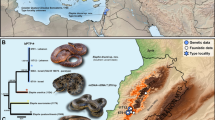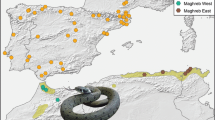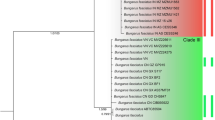Abstract
King brown snakes or mulga snakes (Pseudechis australis) are the largest and among the most dangerous and wide-ranging venomous snakes in Australia and New Guinea. They occur in diverse habitats, are important predators, and exhibit considerable morphological variation. We infer the relationships and historical biogeography of P. australis based on phylogenetic analysis of 1,249 base pairs from the mitochondrial cytochrome b, NADH dehydrogenase subunit 4 and three adjacent tRNA genes using Bayesian, maximum-likelihood, and maximum-parsimony methods. All methods reveal deep phylogenetic structure with four strongly supported clades comprising snakes from New Guinea (I), localities all over Australia (II), the Kimberleys of Western Australia (III), and north-central Australia (IV), suggesting a much more ancient radiation than previously believed. This conclusion is robust to different molecular clock estimations indicating divergence in Pliocene or Late Miocene, after landbridge dispersal to New Guinea had occurred. While members of clades I, III and IV are medium-sized, slender snakes, those of clade II attain large sizes and a robust build, rendering them top predators in their ecosystems. Genetic differentiation within clade II is low and haplotype distribution largely incongruent with geography or colour morphs, suggesting Pleistocene dispersal and recent ecomorph evolution. Significant haplotype diversity exists in clades III and IV, implying that clade IV comprises two species. Members of clade II are broadly sympatric with members of both northern Australian clades. Thus, our data support the recognition of at least five species from within P. australis (auct.) under various criteria. We discuss biogeographical, ecological and medical implications of our findings.




Similar content being viewed by others
References
Arbogast BS, Slowinski JB (1998) Pleistocene speciation and the mitochondrial DNA clock. Science 282:1955a
Arbogast BS, Edwards SV, Wakeley J, Beerli P, Slowinski JB (2002) Estimating divergence times from molecular data on phylogenetic and population genetic timescales. Annu Rev Ecol Syst 33:707–740
Bonett RM, Chippindale PT (2004) Speciation, phylogeography and evolution of life history and morphology in plethodontid salamanders of the Eurycea multiplicata complex. Mol Ecol 13:1189–1203
Brown WM, George Jr M, Wilson AC (1979) Rapid evolution of animal mitochondrial DNA. Proc Natl Acad Sci USA 76:1967–1971
Burbrink FT, Lawson R, Slowinski JB (2000) Mitochondrial DNA phylogeography of the polytypic North American rat snake (Elaphe obsoleta): a critique of the subspecies concept. Evolution 54:2107–2118
Chippaux J-P, Williams V, White J (1991) Snake venom variability: methods of study, results and interpretation. Toxicon 29:1279–1303
Cogger HG (2002) Reptiles and amphibians of Australia. New Holland, Sydney
Covacevich J (1989) Aspects of the biogeography of the elapid snakes of northeastern Australia. In: Longmore R (ed) Atlas of elapid snakes of Australia. Australian Government Publishing Service, Canberra, pp 20–22
de Queiroz A, Lawson R, Lemos-Espinal JA (2002) Phylogenetic relationships of North American Garter Snakes (Thamnophis) based on four mitochondrial genes: how much DNA sequence is enough? Mol Phylogenet Evol 22:315–329
de Queiroz K (1998) The general lineage concept of species, species criteria, and the process of speciation: a conceptual unification and terminological recommendations. In: Howard DJ, Berlocher SH (eds) Endless forms: species and speciation. Oxford University Press, New York, pp 57–75
Forstner MRJ, Davis SK, Arévalo E (1995) Support for the hypothesis of anguimorph ancestry for the suborder Serpentes from phylogenetic analysis of mitochondrial DNA sequences. Mol Phylogenet Evol 4:93–102
Godthelp H (2001) The Australian rodent fauna, flotilla’s flotsam or just fleet footed? In: Metcalfe I, Smith JMB, Morwood M, Davidson I (eds) Faunal and floral migrations and evolution in S.E. Asia–Australasia. Balkema, Lisse, pp 319–322
Gow GF (1989) Graeme Gow’s complete guide to Australian snakes. Angus & Robertson, North Ryde, New South Wales
Hoser R (2001) A current assessment of the status of the snakes of the genera Cannia and Pailsus, including descriptions of three new subspecies from the Northern Territory and Western Australia, Australia. J Herpetol Soc Queensl 2001:26–60
Huelsenbeck JP, Ronquist FR (2001) MrBayes: Bayesian inference of phylogeny. Bioinformatics 17:754–755
Keogh JS, Shine R, Donnellan S (1998) Phylogenetic relationships of terrestrial Australo-Papuan elapid snakes based on cytochrome b and 16S rRNA sequences. Mol Phylogenet Evol 10:67–81
Keogh JS, Scott IAW, Fitzgerald M, Shine R (2003) Molecular phylogeny of the Australian venomous snake genus Hoplocephalus (Serpentes, Elapidae) and conservation genetics of the threatened H. stephensii. Conserv Genet 4:57–65
Keogh JS, Scott IAW, Hayes C (in press) Rapid and repeated origin of insular gigantism and dwarfism in Australian tiger snakes. Evolution
Kocher TD, Thomas WK, Meyer A, Edwards SV, Pääbo S, Villablanca FX, Wilson AC (1989) Dynamics of mitochondrial DNA evolution in animals: amplification and sequencing with conserved primers. Proc Natl Acad Sci USA 86:6196–6200
Kuch U, Pfenninger M, Bahl A (1999) Laundry detergent effectively preserves amphibian and reptile blood and tissue for DNA isolation. Herpetol Rev 30:80–82
Kuch U, Molles BE, Satoh T, Chanhome L, Samejima Y, Mebs D (2003) Identification of alpha-bungarotoxin (A31) as the major postsynaptic neurotoxin, and complete nucleotide identity of a genomic DNA of Bungarus candidus from Java with exons of the Bungarus multicinctus alpha-bungarotoxin (A31) gene. Toxicon 42:381–390
Kuch U, Kizirian D, Truong NQ, Donnelly MA, Mebs D (in press) A new species of krait (Elapidae: Bungarus) from the Red River system of northern Vietnam. Copeia
Kumar S (1996) PHYLTEST: a program for testing phylogenetic hypothesis, Version 2. Pennsylvania State University, University Park, PA
Maryan B (1997) Is “King Brown Snake” an appropriate common name for Pseudechis australis? Herpetofauna 27:20–22
McGuigan K, Zhu D, Allen GR, Moritz C (2000) Phylogenetic relationships and historical biogeography of melanotaeniid fishes in Australia and New Guinea. Mar Freshwater Res 51:713–723
Mebs D (2001) Toxicity in animals: trends in evolution? Toxicon 39:87–96
Olson LE, Goodman SM, Yoder AD (2004) Illumination of cryptic species boundaries in long-tailed shrew tenrecs (Mammalia: Tenrecidae: Microgale), with new insights into geographic variation and distributional constraints. Biol J Linn Soc 83:1–22
Posada D, Crandall KA (2001) Selecting the best-fit model of nucleotide substitution. Syst Biol 50:580–601
Rawlings LH, Donnellan SC (2003) Phylogeographic analysis of the green python, Morelia viridis, reveals cryptic diversity. Mol Phylogenet Evol 27:36–44
Rawlings LH, Barker D, Donnellan SC (2004) Phylogenetic relationships of the Australo-Papuan Liasis pythons (Reptilia: Macrostomata), based on mitochondrial DNA. Aust J Zool 52:215–227
Shine R (1998) Australian snakes. A natural history. Reed New Holland, Sydney
Smales LR, Spratt DM (2004) Helminth community structure in Rattus leucopus (Gray) (Muridae) from Australia, Papua New Guinea and Papua. Aust J Zool 52:283–291
Smith LA (1982) Variation in Pseudechis australis (Serpentes: Elapidae) in Western Australia and description of a new species of Pseudechis. Rec West Aust Mus 10:35–45
Swofford DL (2003) PAUP: Phylogenetic analysis using parsimony (* and other methods), Version 4.0b10. Sinauer, Sunderland, MA
Takezaki N, Razhetsky A, Nei M (1995) Phylogenetic test of the molecular clock and linearized trees. Mol Biol Evol 12:823–833
Torgersen T, Jones MR, Stephens AW, Searle DE, Ullman WJ (1985) Late Quaternary hydrological changes in the Gulf of Carpentaria. Nature 313:785–787
Wüster W, Bush B, Keogh JS, O’Shea M, Shine R (2001) Taxonomic contributions in the “amateur” literature: comments on recent descriptions of new genera and species by Raymond Hoser. Litt Serpent 21:67–91
Wüster W, Salomão MG, Quijada-Mascareñas JA, Thorpe RS, BBBSP (2002) Origins and evolution of the South American pitviper fauna: evidence from mitochondrial DNA sequence analysis. In: Schuett GW, Höggren M, Douglas ME, Greene HW (eds) Biology of the vipers. Eagle Mountain Publishing, Eagle Mountain, Utah, pp 111–128
Acknowledgements
We thank R. Hoser, R. MacCulloch and R. W. Murphy (Royal Ontario Museum, Toronto), R. Pails, R. Sadlier (Australian Museum, Sydney) and F. B. Yuwono for tissue samples, and L. Driver and B. Maryan (Western Australian Museum, Perth) for photographs. J. S. K. thanks the Australian Research Council for ongoing support. All animal care and experimental procedures complied with the current laws of the state or country where they were performed.
Author information
Authors and Affiliations
Corresponding author
Electronic Supplementary Material
Rights and permissions
About this article
Cite this article
Kuch, U., Keogh, J.S., Weigel, J. et al. Phylogeography of Australia’s king brown snake (Pseudechis australis) reveals Pliocene divergence and Pleistocene dispersal of a top predator. Naturwissenschaften 92, 121–127 (2005). https://doi.org/10.1007/s00114-004-0602-0
Received:
Accepted:
Published:
Issue Date:
DOI: https://doi.org/10.1007/s00114-004-0602-0




